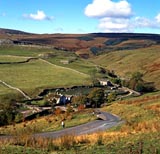Farm building conversions will get easier
It will get easier to turn redundant farm buildings for residential use, the Government has announced


Country estate agents welcomed this week's information from Planning Minister Nick Boles it is going to get easier to convert redundant agricultural buildings into residential dwellings.
‘The ability to make better use of farm buildings that are inappropriate for modern farming systems will really benefit rural areas," says James Del Mar, Head of Rural Consultancy at Knight Frank. The ministerial statement follows a public consultation launched last August that proposed planning permission would no longer be required to convert redundant farm buildings of up to 450 sq metres into residential dwellings.
Originally, the proposed new rights would have been restricted to three dwellings up to a maximum of 150 sq metres per house. Although the full details have yet to be published, Mr Boles' statement suggests that the 150 sq-metre limit has been removed and single dwellings up to the total threshold will be allowed. ‘This makes sense, because trying to convert one building into three separate dwellings, or just using a small part of it for one house, might have been more detrimental to its historic integrity than converting it as whole,' says Mr Del Mar.
Experts at Savills have had a similar reaction: Associate Tim Bamford commented: ‘For too long planning policy has leant towards large scale developments, which is stifling the natural growth of rural communities. The new provisions will help struggling rural communities and provide a valid use for redundant buildings.'
Savills also points out that the conversion of agricultural buildings to residential avoids the problems of new dwellings in rural areas often being subject to an agricultural occupancy condition. Any schemes will of course be subject to a process of ‘prior approval' from the Council to ensure consideration is given towards matters such as flooding and design.
However, other ideas which were in the original proposals constitute further missed opportunities: ‘The most disappointing of these is that the new permitted development rights will not apply in designated areas such as National Parks,' Mr Del Mar contined. ‘It is entirely possible to safeguard protected landscapes, while still allowing better use to be made of redundant buildings within or near to farmyards and steadings.'
Sign up for the Country Life Newsletter
Exquisite houses, the beauty of Nature, and how to get the most from your life, straight to your inbox.
* Follow Country Life magazine on Twitter
-
 380 acres and 90 bedrooms on the £25m private island being sold by one of Britain's top music producers
380 acres and 90 bedrooms on the £25m private island being sold by one of Britain's top music producersStormzy, Rihanna and the Rolling Stones are just a part of the story at Osea Island, a dot on the map in the seas off Essex.
By Lotte Brundle Published
-
 'A delicious chance to step back in time and bask in the best of Britain': An insider's guide to The Season
'A delicious chance to step back in time and bask in the best of Britain': An insider's guide to The SeasonHere's how to navigate this summer's top events in style, from those who know best.
By Madeleine Silver Published
